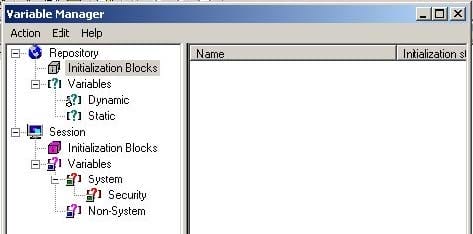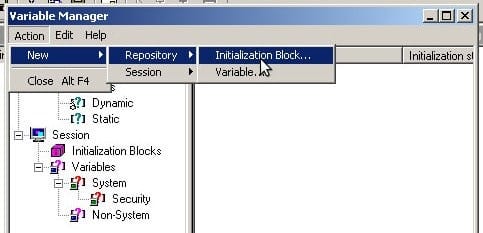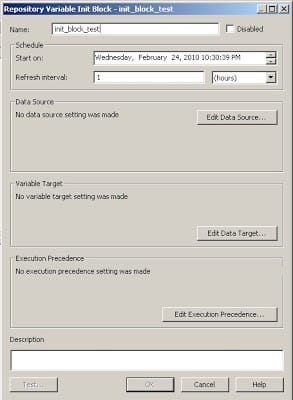Exam Details
Exam Code
:1Z0-591Exam Name
:Oracle Business Intelligence Foundation Suite 11g EssentialsCertification
:Oracle CertificationsVendor
:OracleTotal Questions
:120 Q&AsLast Updated
:Jun 28, 2025
Oracle Oracle Certifications 1Z0-591 Questions & Answers
-
Question 1:
Which two steps are needed to set up Failover support for an OBIEE deployment?
A. Use Installer to affect Horizontal scale out of an existing instance B. Employ WebLogic Enterprise Edition, licensed separately
C. Use Installer to set up separate single instances, then apply Horizontal scale out clustering
D. Apply OBIEE Clustering option
E. Leverage spare hardware capacity of single machine by using Vertical scale out option
-
Question 2:
When creating an initialization Block, which BI Administration function is used?
A. Variable Manager
B. Job Manager
C. Identity Manager
D. Projects Manager
-
Question 3:
Object Security controls access to Subject Areas, Tables, and Columns in OBIEE and can be implemented by using which method?
A. Single Sign-On (SSO)
B. Database Authentication
C. Business Logic Object Security
D. External Table Authentication
E. LDAP Authentication
-
Question 4:
An integrated BI tools business case can be built around which three options?
A. Scalability
B. Fault tolerance
C. Cost Savings
D. Development efficiency
-
Question 5:
What are the two ways to use the administration tool?
A. It can be used to manage user password.
B. The administration tool uses a set of wizards that support the design of calculations, expressions, dimensions, and so on.
C. It can be used for versioning of the rpd.
D. Administrator can use repository and session variables in a repository to streamline administrative tasks and dynamically modify metadata content to adjust to a changing data environment.
-
Question 6:
Use of the Enterprise Install option is recommended for which three options?
A. Multiple instances on a single computer
B. Scale out for High Availability and Failover
C. Support for high security requirements
D. Evaluation of end user functionality
E. Single users working on a single computer
-
Question 7:
Which option is not an example of a level-based measure?
A. Regional Revenue
B. Sales
C. Brand Cost
D. Employee Salary
-
Question 8:
Selecting the Manage Map Data link allows one to do which three of the following?
A. Associate map layers to columns defined in the OBIEE metadata
B. Create a new map layer
C. Set the zoom level of an imported map
D. Import images for use on maps
-
Question 9:
How do System Session Variables obtain their values?
A. They are entered by user input on a dashboard
B. They are obtained from data fields in the Physical Layer
C. They are obtained from the Presentation Layer
D. They are obtained from the Initialization Block
-
Question 10:
You run the Consistency Check and receive the warning: [39003] Missing functional dependency association for column: DIM_Offer_End_Date.CREATE_DT.
What would you check?
A. Whether the logical table source for this column has been disabled
B. Whether the columns creating CREATE_DT have been deleted
C. Whether there is a logical join between the DIM and FACT tables
D. Whether there is a physical join between the DIM and FACT tables
E. Whether there is a physical column mapped to the logical column
F. DIM_Offer_End_Date.CREATE_DT
Related Exams:
1Z0-020
Oracle8i: New Features for Administrators1Z0-023
Architecture and Administration1Z0-024
Performance Tuning1Z0-025
Backup and Recovery1Z0-026
Network Administration1Z0-034
Upgrade Oracle9i/10g OCA to Oracle Database OCP1Z0-036
Managing Oracle9i on Linux1Z0-041
Oracle Database 10g: DBA Assessment1Z0-052
Oracle Database 11g: Administration Workshop I1Z0-053
Oracle Database 11g: Administration II
Tips on How to Prepare for the Exams
Nowadays, the certification exams become more and more important and required by more and more enterprises when applying for a job. But how to prepare for the exam effectively? How to prepare for the exam in a short time with less efforts? How to get a ideal result and how to find the most reliable resources? Here on Vcedump.com, you will find all the answers. Vcedump.com provide not only Oracle exam questions, answers and explanations but also complete assistance on your exam preparation and certification application. If you are confused on your 1Z0-591 exam preparations and Oracle certification application, do not hesitate to visit our Vcedump.com to find your solutions here.


